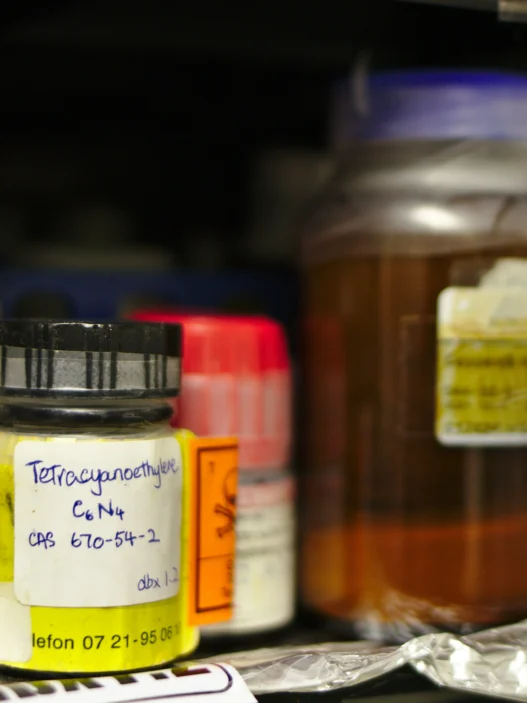Ethylamine, a chemical compound with the formula C2H5NH2, holds significant relevance in everyday life due to its versatile applications. It is commonly used in the production of pharmaceuticals, pesticides, and rubber production. Additionally, ethylamine plays a crucial role in the manufacturing of cleaning agents, dyes, and plastics. Its presence can also be found in various household products such as cosmetics, fertilizers, and textiles. In summary, ethylamine serves as a key ingredient in numerous industries, contributing to various aspects of modern life.
Table of Contents:
Commercial Applications
Chemical & Physical Properties
Production & Procurement
Safety Considerations
Potential Research Directions
Related Compounds
 Commercial Applications
Commercial Applications
Ethylamine, a simple primary amine, has various commercial and industrial applications. It is commonly used in the production of pesticides, pharmaceuticals, and rubber chemicals. Additionally, ethylamine is utilized in the manufacturing of dyes, surfactants, and corrosion inhibitors due to its ability to function as a base in organic synthesis.
In terms of drug and medication applications, ethylamine plays a crucial role in the pharmaceutical industry. It is used as a precursor in the synthesis of various medications, including analgesics, anesthetics, and antihistamines. Ethylamine is also utilized in the production of local anesthetics and muscle relaxants due to its ability to react with different chemical compounds to form pharmacologically active molecules.
Moreover, ethylamine is employed in the synthesis of antidepressants, anti-infective agents, and antimalarial drugs. Its reactivity and versatility make it a valuable building block for the creation of novel pharmaceutical compounds with enhanced therapeutic properties. Ethylamine derivatives are key components in the development of innovative drug formulations aimed at treating a wide range of medical conditions effectively.
 Chemical & Physical Properties
Chemical & Physical Properties
Ethylamine, also known as monoethylamine, is a colorless liquid with a strong, ammonia-like odor. It has a highly pungent smell, reminiscent of rotten fish or ammonia.
The molar mass of ethylamine is approximately 45 g/mol, with a density of 681 kg/m³. In comparison to common food items, ethylamine has a lower molar mass than sucrose (342.3 g/mol) and a similar density to olive oil (about 800 kg/m³).
Ethylamine has a melting point of -80.8°C and a boiling point of 16.6°C. In contrast to common food items like salt (melting point of 801°C) and water (boiling point of 100°C), ethylamine has much lower melting and boiling points.
Ethylamine is highly soluble in water, forming a clear solution. It has a low viscosity, similar to water, making it easy to mix and dissolve. In comparison, common food items like sugar and salt are also soluble in water but have higher viscosities.
 Production & Procurement
Production & Procurement
Ethylamine is primarily produced through the reaction of ethylene with ammonia in the presence of a catalyst. This process, known as the ethylamine process, results in the formation of ethylamine as well as diethylamine and triethylamine as byproducts.
Ethylamine can also be procured through the direct purchase from chemical manufacturers or distributors. The compound is commonly available in both liquid and gaseous forms, depending on its intended use. Transportation of ethylamine typically involves the use of specialized containers or tankers to ensure safe handling and delivery.
Due to its flammable and corrosive nature, ethylamine requires careful handling and storage. It is important for personnel involved in the production, procurement, and transportation of ethylamine to adhere to strict safety protocols and regulations to prevent accidents and ensure the safe handling of the compound.
 Safety Considerations
Safety Considerations
Safety considerations for Ethylamine involve its highly flammable nature, which poses a risk of fire or explosion when in contact with air, heat, or open flame. Ethylamine may also react violently with oxidizing agents, acids, and other incompatible materials, leading to potential hazards. It is crucial to store Ethylamine in a cool, well-ventilated area and handle it with caution to prevent any accidents or exposure to its toxic properties. Personal protective equipment, such as gloves, goggles, and a lab coat, should be worn when working with Ethylamine to minimize the risk of skin or eye contact.
The hazard statements associated with Ethylamine include its classification as a highly flammable liquid and vapor, which can ignite easily and pose a fire hazard. It is also labeled as toxic if inhaled, causing respiratory irritation and potentially leading to serious health effects. Additionally, Ethylamine is known to be corrosive to metals and may react with water to produce flammable gases. These hazard statements highlight the importance of handling Ethylamine with care and implementing proper safety measures to minimize risks to health and the environment.
Precautionary statements for Ethylamine emphasize the need for strong ventilation systems and adequate personal protective equipment to prevent exposure to its harmful effects. It is recommended to use only in well-ventilated areas and avoid breathing in vapors or mist. Additionally, precautions should be taken when storing and handling Ethylamine to prevent spills and leaks, which could result in fires or environmental contamination. In case of accidental exposure or ingestion, immediate medical attention should be sought, and contaminated clothing should be removed to prevent further skin contact. These precautionary statements underline the importance of following safety protocols and procedures when working with Ethylamine to ensure a safe working environment.
 Potential Research Directions
Potential Research Directions
One potential research direction for Ethylamine lies in its use as a precursor in the synthesis of various pharmaceuticals and agricultural chemicals. Studies exploring new synthetic methodologies to efficiently produce Ethylamine derivatives could lead to the development of novel therapeutic agents and agrochemicals with improved properties.
Another area of research interest involves investigating the biological activities of Ethylamine and its derivatives. Understanding the pharmacological effects of Ethylamine on biological systems could provide valuable insights into its potential use as a drug candidate for the treatment of various diseases. Additionally, studying the toxicological profile of Ethylamine is essential for assessing its safety for human and environmental exposure.
Furthermore, exploring the catalytic conversion of Ethylamine into value-added products such as amino acids, polymers, and solvents is an area of growing interest. Developing efficient catalytic processes for the transformation of Ethylamine can contribute to the sustainable utilization of this important chemical building block. Investigations into the mechanistic aspects of these catalytic reactions can pave the way for the design of more selective and environmentally friendly processes.
 Related Compounds
Related Compounds
One similar compound to Ethylamine based on molecular structure is Methylamine. Methylamine has a similar structure to ethylamine but contains one less carbon atom in its chain, resulting in the formula CH3NH2. Like ethylamine, methylamine is a primary amine and possesses similar reactivity and chemical properties.
Another compound structurally similar to Ethylamine is Dimethylamine. Dimethylamine is a secondary amine with the formula (CH3)2NH. It contains two methyl groups attached to the amino nitrogen atom, making it distinct from both ethylamine and methylamine. Dimethylamine also exhibits characteristic properties of amines, such as basicity and nucleophilicity, similar to ethylamine.
A compound structurally related to Ethylamine is Trimethylamine. Trimethylamine has the formula (CH3)3N and contains three methyl groups attached to the nitrogen atom. This compound is a tertiary amine, unlike ethylamine, methylamine, and dimethylamine, which are primary and secondary amines. Trimethylamine shares some chemical properties with ethylamine due to its amine functional group.





